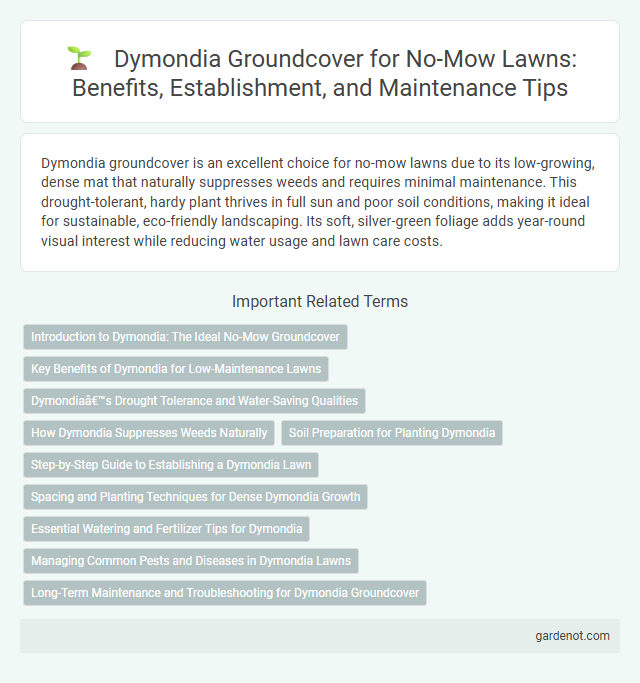Dymondia groundcover is an excellent choice for no-mow lawns due to its low-growing, dense mat that naturally suppresses weeds and requires minimal maintenance. This drought-tolerant, hardy plant thrives in full sun and poor soil conditions, making it ideal for sustainable, eco-friendly landscaping. Its soft, silver-green foliage adds year-round visual interest while reducing water usage and lawn care costs.
Introduction to Dymondia: The Ideal No-Mow Groundcover
Dymondia, a low-growing, drought-tolerant groundcover, is an ideal choice for no-mow lawns due to its dense, carpet-like growth that suppresses weeds and requires minimal maintenance. Its silver-green foliage thrives in full sun and adapts well to various soil types, making it perfect for sustainable landscaping. By reducing the need for mowing, watering, and fertilizers, Dymondia supports eco-friendly lawn care and conserves resources.
Key Benefits of Dymondia for Low-Maintenance Lawns
Dymondia groundcover excels in creating no-mow lawns by providing drought tolerance, weed suppression, and a dense, low-growing mat that requires minimal water and maintenance. Its ability to thrive in poor soils and resist foot traffic makes it an ideal choice for sustainable, low-maintenance landscaping. The silver-green foliage and yellow daisy-like flowers enhance curb appeal while reducing the need for mowing and chemical treatments.
Dymondia’s Drought Tolerance and Water-Saving Qualities
Dymondia groundcover thrives in drought-prone environments, requiring minimal water once established, making it an excellent choice for no-mow lawns. Its deep-rooted system enhances soil moisture retention and reduces irrigation needs by up to 50% compared to traditional grass lawns. This drought tolerance and water-saving quality contribute significantly to sustainable landscaping and water conservation efforts.
How Dymondia Suppresses Weeds Naturally
Dymondia groundcover forms a dense, low-growing mat that effectively blocks sunlight from reaching weed seeds, inhibiting their germination and growth. Its thick foliage shades the soil, reducing moisture evaporation, which creates an environment less favorable for invasive weeds. This natural weed suppression minimizes the need for chemical herbicides, making Dymondia an eco-friendly choice for no-mow lawns.
Soil Preparation for Planting Dymondia
Soil preparation for planting Dymondia groundcover requires well-draining soil with a pH level between 6.0 and 7.5 for optimal growth. Incorporate organic matter such as compost or aged manure to improve soil fertility and moisture retention, ensuring a healthy root system. Before planting, loosen the soil to a depth of 6 to 8 inches to promote root establishment and reduce compaction.
Step-by-Step Guide to Establishing a Dymondia Lawn
Dymondia groundcover thrives in well-drained, sandy soils with full sun exposure, making it an ideal low-maintenance alternative to traditional grass lawns. Begin by preparing the soil, removing weeds and debris, and lightly tilling the area to improve root establishment. Space Dymondia plants 6 to 12 inches apart, water regularly during the first six weeks, and expect a dense, drought-tolerant carpet within 3 to 4 months.
Spacing and Planting Techniques for Dense Dymondia Growth
Plant Dymondia groundcover 8 to 12 inches apart to promote dense, low-maintenance coverage that minimizes weed growth and soil erosion. Space adjustments based on site conditions, such as soil type and sun exposure, enhance root establishment and optimize drought resistance. Employ shallow, well-prepared soil beds with consistent moisture for the first few weeks to encourage vigorous growth and rapid mat formation.
Essential Watering and Fertilizer Tips for Dymondia
Dymondia groundcover thrives with minimal water, requiring deep watering only once every two weeks during dry periods to maintain its drought tolerance. Fertilize Dymondia sparingly with a balanced, slow-release fertilizer in early spring and mid-summer to promote healthy growth without encouraging excessive foliage. Overwatering and excessive fertilization can lead to shallow roots and reduced stress resistance in this low-maintenance, no-mow groundcover.
Managing Common Pests and Diseases in Dymondia Lawns
Dymondia groundcover is naturally resistant to many common lawn pests, but occasional infestations of aphids and spider mites can occur, requiring regular inspection and targeted insecticidal soap treatments. To manage fungal diseases such as root rot and leaf spot, ensure proper soil drainage and avoid overwatering in Dymondia lawns. Maintaining good air circulation by spacing plants appropriately helps prevent disease development, preserving the aesthetic and health of no-mow lawns.
Long-Term Maintenance and Troubleshooting for Dymondia Groundcover
Dymondia groundcover requires minimal long-term maintenance, thriving with occasional trimming and light watering to preserve its dense carpet-like appearance. Regularly check for weed intrusion and remove invasive plants promptly to prevent competition and maintain growth health. Troubleshooting common issues like yellowing leaves often involves adjusting watering schedules or improving soil drainage to avoid root rot.
Dymondia groundcover Infographic

 gardenot.com
gardenot.com